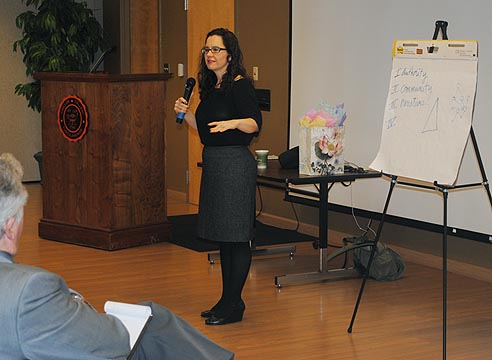
The Rev. Carol Howard Merritt discusses different ways new churches are being founded during the last session of the Theologian-in-Residence series.
The concluding session of the annual Theologian-in-Residence lecture series at Tusculum College focused on successful ways churches have been able to nurture intergenerational congregations.
The Rev. Carol Howard Merritt, author of “Tribal Church” and “Reframing Hope,” has led the series, which is co-sponsored by the Holston Presbytery of the Presbyterian Church (U.S.A.) and the college with funding assistance from Ron Smith.
Rev. Merritt, who is co-host of God Complex Radio and blogger for Christian Century and Huffington Post, began the session recalling the stories of Abraham and Hagar and their journeys into wilderness areas in the Old Testament.
“These stories tell us that our faith is not just about ourselves, but it is to be moving and breathing from generation to generation,” she said. “They also show that whatever desperate situation we may be in, God still moves in dry, desert places.”
The church has been in a wilderness time, but God is working and there have been some successes with different ways to reach out to the younger generation, Rev. Merritt said.
In the past, people would pick a spot to build a church and expect people to come, she continued, but now people are seeing how God is working in a community and then building friendships and relationships to form a church around that work.
Trying to engage people in their 20s and 30s, churches have tended to think that edgy, interesting ministries are the key, Rev. Merritt said, but that is not necessarily the case.
One of the things working with younger generations is contemplative prayer, she said. While younger people are part of an image-based culture, Rev. Merritt, continued, there is a longing for times when people can breathe, still themselves and listen to God and each other.
But, she cautioned, sometimes there can be intergenerational tension with changes in services to include contemplative prayer or other types of worship. She told of an experience as a pastor when Lenten services were held that provided times for individual prayer, worship and reflection and included candles and incantations. Although it did attract college students and other younger adults as desired, it was not continued because some older members did not like the changes.
Rev. Merritt also discussed the different church models that are arising. One is a church hosting a nesting community, which involves having different services and programs for different groups of people. A nesting community may be a solution when there is tension between generations in regards to type of service or other issues or for a migrant population in the church, she said.
Another is a church partnering with an emerging church. Rev. Merritt explained that an emerging church is one typically formed by people who have left a megachurch or another mainline denomination and may meet in someone’s home. Their worship services vary but usually include ways that people can commune with God involving sight, sound or smell. Churches can invite the emerging church to meet in its building as a partnership in which both sides can learn from one another, she continued.
Churches are also being formed that focus on a type of food ministry such as a soup kitchen or food bank, she said, and there have been churches started related to artwork.
Business and church hybrids in which a church also includes a business, such as a coffeehouse, are being created, Rev. Merritt continued.
Many churches cannot afford to pay a full-time minister so bivocational ministry for pastors is becoming more common, she said. Seminaries are responding to this need by offering degrees in divinity and some other discipline such as social work, law or nursing so new ministers can more easily be bivocational. Related is a team ministry concept in which four or five congregations come together and share two or three ministers.
Some are thinking more of church as a community in which people worship together, study together and serve together, but is not necessarily tied to one place, she said, and there are churches that are forming that only meet together on the Internet.
To help bring more people into congregations, churches need to learn to tell their stories within the community – in small groups, prayer services, Wednesday night services and on Facebook and Twitter, Rev. Merritt said. Leaders can also ask questions of members to allow them to tell their stories of how God has worked in their lives or helped them make a decision.
When the surrounding community sees what the church is doing, it does bring more people, she added. “If you are reaching out the new generation and wanting to reach an action-oriented generation, you want to tell them what you do, what you are doing in the community and how you are helping people.”
Service to others is also a good way for different generations to connect and learn from each other, she said.


